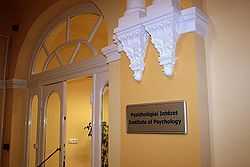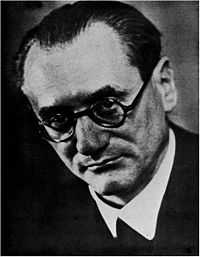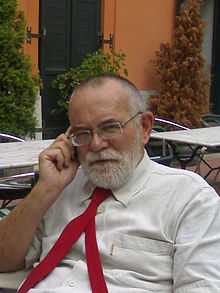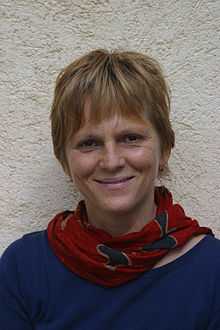Institute of Psychology (Szeged)
| Institute of Psychology | |
| University of Szeged Faculty of Arts | |
 | |
 | |
| Built: | in 1912, in Neo-Roman style |
| Address: | 6722 Szeged, Egyetem utca 2. |
| Founded: | 18 December 1929. |
| Anniversary: | 80th (1929–2009) |
| Official homepage: | http://www.pszich.u-szeged.hu/ |
Institute of Psychology of the University of Szeged, Szeged, Hungary, is located at 2 Egyetem Street, at the Szeged University Campus of the Faculty of Arts. The Institute of Psychology in Szeged is the longest-standing psychology institute in Hungary (founded on 18 December 1929).[1]
Today, the Institute provides a three-year Psychology Bachelor of Arts (BA) training, followed by a two-year Master of Arts (MA) course in two possible majors: Cognitive and Neuropsychology, or Counseling and Educational Psychology.
The beginnings (1872-1919)
The legal predecessor of the University of Szeged was the University of Cluj-Napoca (Kolozsvár), which was founded in 1872 by Franz Joseph as the second university in Hungary of that time.[2] Psychology-oriented studies existed from the earliest days, but were taught by professors of Philosophy and Pedagogy. Psychology was first recognized as a separate subject by Professor Imre Sándor at the University of Szeged.
The beginnings of psychology education in Szeged (1921-1929)

_pedagogue.jpg)
By 1919, the turmoils of history forced the University of Cluj-Napoca to relocate, and in 1921, the Hungarian National Assembly (according to the terms of Act XXV of 1921) designated the town of Szeged as the temporary location of the university. The former campus site was the Neo-Renaissance building in Szeged's Dugonics Square, originally built as a secondary school for modern languages and sciences in 1873. From 1925, the Faculty of Arts and part of the Faculty of Sciences were moved to the Neo-Roman building at 2 Egyetem Street, formerly a railway discount broker's office. The three-story building was built in 1912, according to the plans of Ottoway István and Winkler Imre.[3]
Psychology was first recognized as a major subject at the university by Professor Imre Sándor, who realized that the study of psychology is just as important as that of pedagogy. Accordingly, on 20 October 1926, he filed his petition to the directors of the university for the establishment of a fundamentally different, modern Department of Pedagogy and Psychology. György Málnási Bartók, the Professor of the Department of Philosophy, was an avid supporter of the petition, since the tuition of Psychology had been the responsibility of his department at that period. In his petition, Imre Sándor listed the following fields and branches as belonging to the new Department's sphere of competence: General Psychology, Developmental Psychology, Psychology of Differences, Education of Backward Children, Psychotechnics, and Pedagogical Somatology.
Psychology education between 1929 and 1940
.jpg)

(1888–1971)
In 1929, the establishment of the Second Department of Pedagogy and Psychology was brought about by lucky circumstances, given that the petition of Imre Sándor and György Málnási Bartók would not have been sufficient by itself. At the University of Szeged, which had been relocated from Cluj-Napoca, the Faculty of Arts had a very low number of attending students, which threatened the very existence of the university. In the fall of 1928, to aid the foundering university, the Minister of Culture, Kuno Klebelsberg, ordered the relocation of the Paedagogum and the academic section of Erzsébet Girls’ School to Szeged. Thus, the Teacher Training College for secular elementary schools was founded. As part of their curriculum, students of the college had to complete a part of their training – essentially one of the two compulsory majors – at the university, hence boosting the number of students there. At the same time, the Minister abrogated secular teacher training at nun schools, which meant that nuns also had to attend the University of Szeged to receive such training.
Kuno Klebelsberg himself did not consider religion an important factor in university appointments. However, under the pressure of Catholic bishops, he founded separate Catholic departments. Thus, the first head of the Second Department of Philosophy was János Mester (1879–1954), a Catholic professor, while the First Department of Philosophy was led by the Protestant György Málnási Bartók. Likewise, the Second Department of Literature and the Second Department of Pedagogy and Psychology were founded with the leaderships of Catholic professor Sándor Sík and Dezső Várkonyi Hildebrand from the Benedictine Order respectively, on the other hand, the Protestant First Department of Literature and the First Department of Pedagogy and Psychology were led by Lajos Dézsi and Sándor Imre respectively. A very useful followed. Both Dezső Várkonyi Hildebrand and Sándor Sík were excellent educators at the university and besides Philosophy, János Mester also engaged himself in studies of Psychology and Pedagogy.
On 18 December 1929, Dezső Hildebrand Várkonyi, a Benedictine monk was appointed as the Head of the Independent Institute of Pedagogy and Psychology. His appointment brought changes to the education at the University of Szeged. In Hungary, such an Independent Institute of Pedagogy and Psychology was founded in Szeged for the first time, only later to be followed by the establishment of the Department of Psychology at the University of Budapest, under the supervision of Pál Schiller Harkai in 1936.
Following the appointment of Várkonyi, psychology training at the University of Szeged could developed further, primarily focusing on the mainstream Psychology of that time, namely on questions of Paedology, Developmental Psychology and Educational Psychology.
Várkonyi introduced more modern fields of Psychology, including the work of Sigmund Freud, Alfred Adler, Carl Gustav Jung and Jean Piaget. According to the recollections of his students, his lectures sometimes deviated from the formal rhetorical style and took on a more familiar character.
In the 1930s, István Boda, a Privatdocent at the University, held a series of lectures on the survey of the intellectuals, and the practical psychology of self-development.
The year 1940 brought another change in the life of the Institute and the university itself. Following the re-annexation of Northern Transylvania, the Franz Joseph University of Sciences was relocated back to Cluj-Napoca, together with the majority of its teachers, Dezső Várkonyi Hildenbrand among them.
Psychology education at Horthy Miklós University of Sciences
_psychologist.jpg)
In 1940, a new university was founded in Szeged, named after Horthy Miklós. The Institute of Psychology was established in 1941, as a new unit, with the Bendectine Pál Bognár Cecil – well known in the scientific circles of the time - appointed as Head of Institute.
Cecil Bognár's work at the Institute was focused on Child Psychology and Educational Science; in his publications, he primarily examined the idiosyncrasies of primary school children, and the issues of child personality types.
The decades following World War II
_pedagogue_and_psychologist.jpg)
Following the retirement of Cecil Bognár, the Institute of Psychology was incorporated into the Institute of Education and Psychology, in the academic year of 1950-1951. It was led by the university's former Privatdocent, Béla Tettamanti (1884–1959).
It is important to note that the amount of Psychology in the curriculum was reduced in the 1950s, mainly due to political reasons. It was taught at a rate of merely two lectures per week, and only the study of General Psychology was allowed. This was due to the influence of high Party echelons, who disapproved of Psychology. Psychology, together with Sociology, was claimed to be seditionary and counter-ideological, and was generally thought of as a media of bourgeois ideology. Thus, under the leadership of Béla Tettamanti, the only possible approach for the Institute was to mimic the Soviet example, and teach in accordance with the ideology prescribed by Karl Marx, Friedrich Engels, Vladimir Lenin and Joseph Stalin.

In 1959, Béla Tettamanti was replaced by the new director of the Institute of Education and Psychology, György Ágoston. Ágoston presented the Marxist pedagogy, nearly eliminated the teaching of mainstream psychology. György Ágoston directed the Institute of Education and Psychology from 1959 to 1970 and the Department of Education between 1970 and 1. January 1990.
The restitution of psychology



Director of Institute of Pschychology
The Department of Psychology became independent from other disciplines in 1970, under the leadership of Lajos Dúró, until 1990. During that period, research and tuition was mainly focused on Educational and Developmental Psychology.
In the early 1990s, the Faculty of Arts of the József Attila University of Sciences called for the reorganization of its departments as institutes. As a result, the Department of Education and the Department of Psychology were merged as the Institute of Education and Psychology.
Under Vajda Zsuzsanna's leadership, Psychology was made available as a major from the academic year 1996/1997; initially under the aegis of the Institute of Psychology (director: Zoltán Kovács) of the Kossuth Lajos University of Sciences (now University of Debrecen).
The founding father of the independent Psychology major, available from the turn of the millennium, is Professor Csaba Pléh, member of the Hungarian Academy of Sciences, who organized the Cognitive Science Group at the Department of Psychology, and in 1999, started the Cognitive Science and Neuropsychology Program of Szeged, or in short, the Cognitive Program. He laid the foundation for a professional psychology training course at the University of Szeged. The university's Medical Faculty and the Cognitive Science Group,[4] led by Csaba Pléh, organized the VIII. Conference of the Hungarian Cognitive Science Association (MAKOG),[5] titled The Development and Disorders of Cognitive Functions for 4–6 February 2000 in Szeged.
From 1 September 1999, the independent Department of Psychology functioned as an independent department at the József Attila University of Sciences (now University of Szeged).
As possibly a final chapter in the long and strife-filled history of Psychology tuition and research in Szeged, Psychology training is again in operation within the Institute of Psychology. The Head of the Institute – and formerly Head of the Department of Psychology – is Associate Professor Ágnes Szokolszky.[6]
In the summer of 2008, the Institute was moved to a new location, into a recently renovated wing of the Faculty of Arts. Currently there are three research laboratories on the premises:
- The Kardos Lajos[7] Laboratory of Cognitive Sciences
- The Grastyán Endre[8] EEG Laboratory
- Mérei Ferenc Behavior Analysis Laboratory (a reference laboratory of Noldus Information Technology)
The Institute of Psychology today
István Winkler[9] is Professor of Psychology at Institute of Psychology, University of Szeged from 2008. He's the Head of the Department of General Psychology, Institute for Psychology, Hungarian Academy of Sciences.
The institute has strong ties to the international Psychology mainstream, as is proven by the lectures given by visiting professors and the large number of students spending months at foreign universities on Erasmus grants.
Present-day affiliations
Renowned guest lecturers in recent years
ERASMUS relations
|
Cooperation with foreign and Hungarian universities
| ||||
Gallery
-
Entrance of the Faculty of Arts, University of Szeged
-

The Faculty of Arts, Szeged University and the József Attila Educational and Information Center Together
-
Institute of Psychology, Szeged University
-

Institute of Psychology, Szeged University
-

The Grastyán Endre EEG Laboratory
-

The Grastyán Endre EEG Laboratory
-

The Grastyán Endre EEG Laboratory
-

Mérei Ferenc Behavior Analysis Laboratory (a reference laboratory of Noldus Information Technology)
See also
- Cognitive Science and Neuropsychology Program of Szeged
- Beat induction
References

| Wikimedia Commons has media related to Institute of Psychology (Szeged). |
- A lélektan 80 éves története a szegedi egyetemen. = The Institute of Psychology at the University of Szeged is 80 years old (1929–2009)/ ed. by Ágnes Szokolszky; authors Szokolszky Ágnes, Pataki Márta, Polyák Kamilla et al. Szeged, JATEPress, 2009. 302 p. ISBN 978-963-482-959-1
- A lélektan 80 éve a szegedi egyetemen (1929–2009) = 80 years' history of psychology in the University of Szeged,[10] with Pataki M., Polyák K., Németh D. Magyar Pszichológiai Szemle, vol. 64. No. 4. December 2009. 671-676. p.
- Pukánszky, B. (1999). Educational Science and Psychology, 215-227. In: Past and Present of Szeged University: 1921-1998. Szeged: Officina.
- Szentirmai, L., Iványi Szabó, É., & Ráczné Mojzes, K. (Eds.) (1996). Almanac of the University of Szeged. Szeged: ISBN 963-482-037-9
- ↑ The first, earliest university was the University of Budapest
- ↑ The name of the second Hungarian university founded in 1872 was University of Cluj-Napoca, from 1882 was called Franz Joseph Royal Hungarian University.
- ↑ Péter, L. (1981). Panorama, pg. 138. Szeged : ISBN 963-243-186-3
- ↑ Cognitiv Science Group, Szeged
- ↑ Cognitive Science Association Conferences, I-XVII. (1993-2009.)
- ↑ Homepage of Ágnes Szokolszky
- ↑ Kardos Lajos (1890-1985) doctor, psychologist, professor of Eötvös Lóránd University. He made achievements in the field of perception studies (phenomenon of constancy). Hungarian Biographical Encyclopedia
- ↑ . Grastyán Endre (1924-1988) neurophysiologist, professor, Correspondent Member of the Hungarian Academy of Sciences, Head of the Physiological Institute of the Pécs Medical University. Hungarian Biographical Encyclopedia
- ↑ Homepage of István Winkler.
- ↑ 80 years' history of psychology in the University of Szeged, 1929-2009.
External links
- Winkler István et al. Newborn infants detect the beat in music
- Cognitiv Science Group, Szeged
- ERASMUS, Szeged
- Homepage of the Institute of Psychology, Szeged University (SZTE Pszichológia Intézetének honlapja)
- Word of cognition from Csaba Pléh
- Béla Pukánszky: Pedagogical and Psychological Scientific Schools in Szeged (Pedagógiai és pszichológiai tudományos iskolák Szegeden)
- The History of Psychologist Training in Szeged, in a Nutshell (A szegedi pszichológus képzés története dióhéjban)
- About the New Laboratories of the Szeged Institute of Psychology: Improvement Helps Education, Research and Healing, Too. Szeged University, 2008. (Új laborokról a Szegedi Pszichológia Intézetben: az oktatást, kutatást és gyógyítást is segíti a fejlesztés, Szegedi Egyetem, 2008)
- Value, Standard, Atmosphere. Szeged University, (Érték, színvonal.hangulat), Szegedi Egyetem, 2009
- At Home, at an International Level. Szeged University (Itthon, de nemzetközi szinten), Szegedi Egyetem, 2007
- The University of Szeged and the Szeged Institute of Psychology in the Press (A SZTE és a Szegedi Pszichológiai Intézet a sajtóban)
- Portrait Gallery (under production)
- Cselekvés Iskolája, Szeged, table of contents
Coordinates: 46°14′51″N 20°08′25″E / 46.24750°N 20.14028°E

